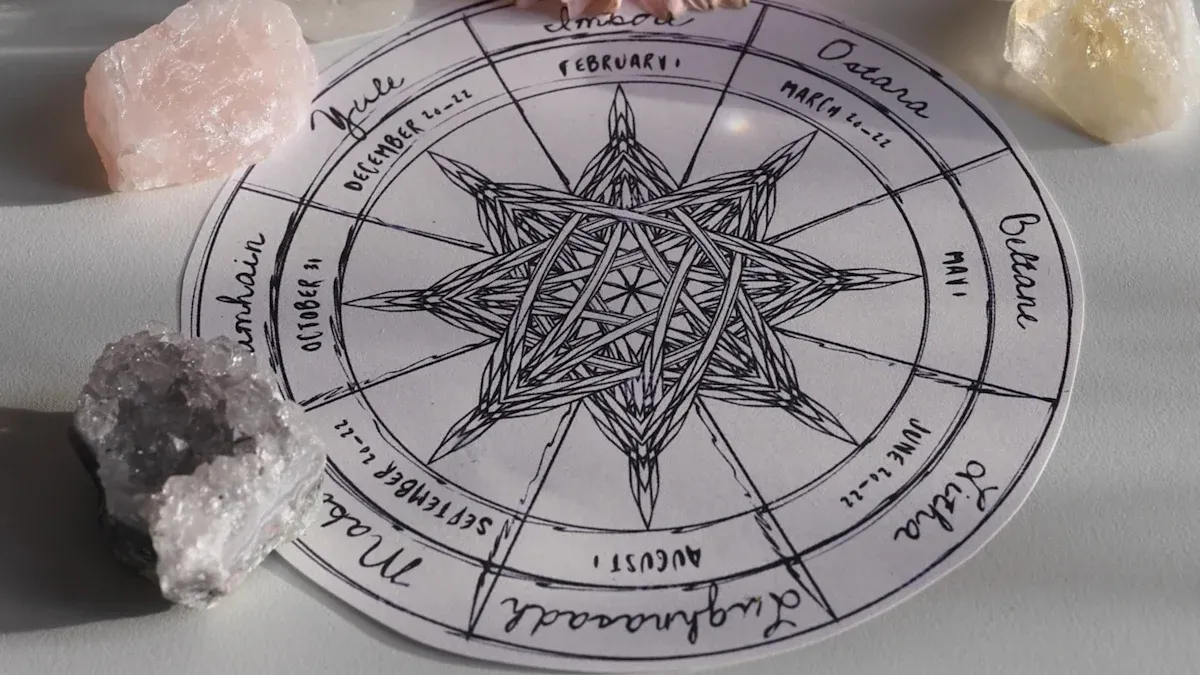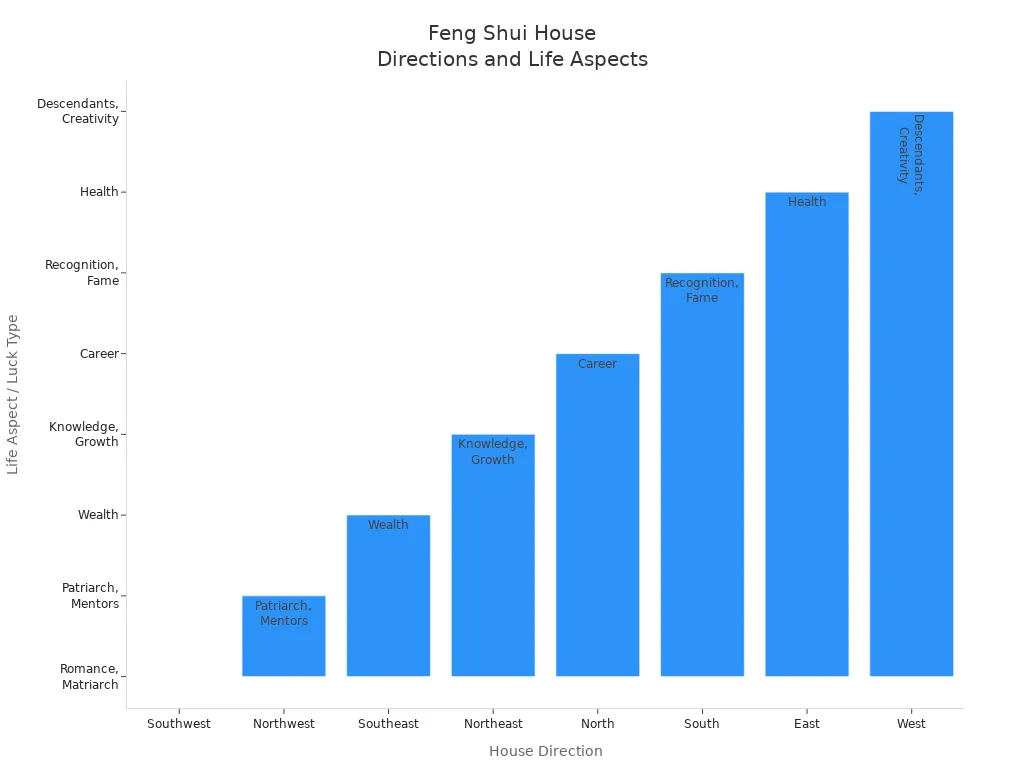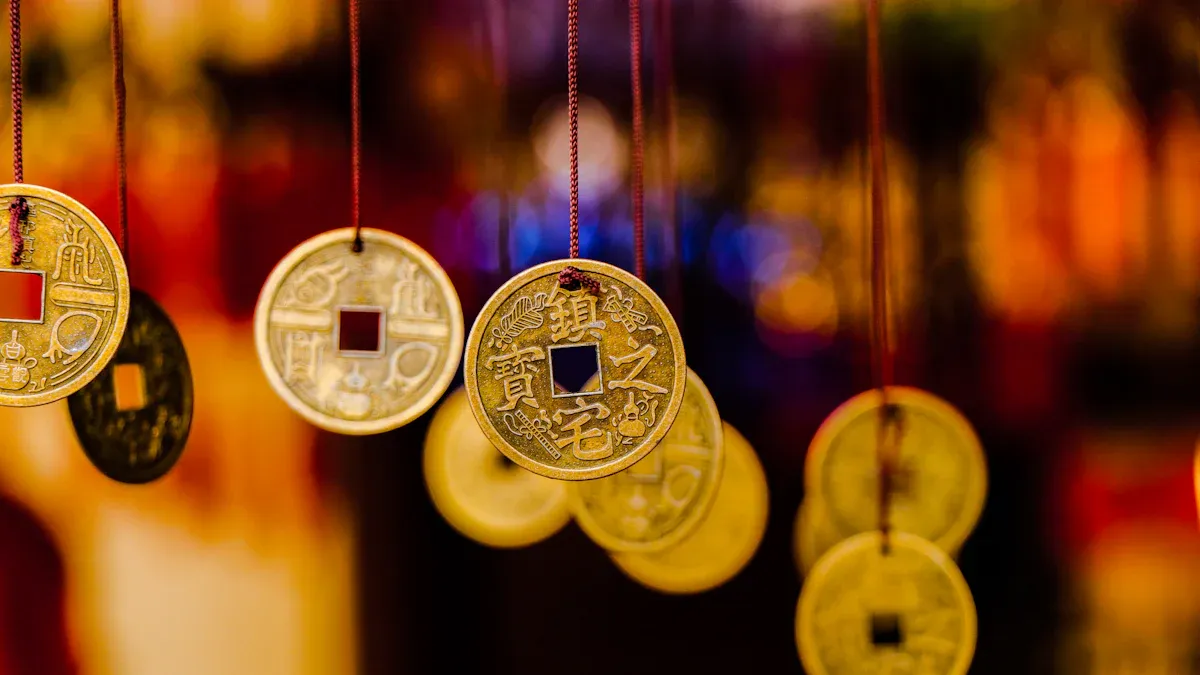
How to Find Your House Direction for Feng Shui Success

To find your feng shui house direction, stand at the main entrance and look outside. Hold a compass or use an app to see the exact direction. The feng shui house direction changes how Qi moves in your home and helps make things peaceful. Experts say you must get the right direction at the main entrance to understand house directions and use Feng Shui correctly. The right feng shui house direction can make your home feel better and may even change how much your house is worth.
Key Takeaways
Stand at your main door. Use a compass or an app to find your house’s real facing direction. This direction changes how energy moves into your home.
Check the main entrance and the busiest side of your house. This helps you get the right feng shui directions. Do not trust only online maps or guesses.
Use your compass results and feng shui kua numbers. Arrange rooms, furniture, and colors to bring harmony, health, and luck.
Make easy layout changes. Use cures like mirrors, plants, and screens to help energy move better and fix problem spots in your home.
Be patient and take compass readings more than once to be sure. Using feng shui carefully can make your home feel calm and balanced.
Find Your Feng Shui House Direction

Main Entrance vs. Center Point
When you want to find your feng shui house direction, you need to start at the main entrance. This is where Qi enters your home. Stand at the main entrance, face outside, and get ready for your first compass reading. The main entrance gives you the direction that most affects how energy flows into your space.
But the main entrance is not always the same as the facing direction of your house. Sometimes, the facing direction is the side that gets the most sunlight, air, and activity. This could be a balcony, a big window, or even a garden. You should look for the most “Yang” side of your home. That’s usually the side with the most light and movement.
To double-check your results, you can also measure from the center point of your house. Find the center by drawing lines between the corners of your floor plan. Where the lines cross is the center. Take a compass reading there to help you map out the directions inside your home. The main entrance reading shows the external facing direction, while the center point helps you plan the layout and zones inside.
Tip: Don’t assume the front door is always the facing direction. Sometimes, the real facing direction is different. Always check both the main entrance and the most active side of your house.
Using a Compass or App
You can use a traditional compass or a smartphone app for checking the facing direction. Both tools work well if you use them the right way. Studies show that iPhone compass apps can be very accurate, with only a small difference from traditional compasses. Still, it’s smart to keep an analog compass as a backup, especially if you use an Android device, since those can be less reliable.
Here’s how you can get the best results:
Stand at the main entrance, facing out.
Hold your compass or phone steady and level.
Make sure you are at least 1-2 meters away from metal objects, cars, or electronics. These can mess up your compass reading.
Align the bottom of your phone or compass with a straight line, like the edge of the door or a wall.
Take a reading and write down the degrees and direction.
Move to the center point of your house and repeat the process.
Take several compass readings from different spots (inside and outside) to make sure your results are accurate.
Note: Always calibrate your compass or app before you start. If you see the needle acting strange or jumping around, move to a different spot and try again.
Common mistakes to avoid:
Relying only on Google Maps or online tools instead of a real compass reading.
Using modern shortcuts that skip proper compass readings.
Professional feng shui consultants take compass readings at the main entrance, inside the house, at the center, and even outside facing the main road. They look for the side with the most activity, sunlight, and Qi flow. This careful process helps you find the true facing direction for your feng shui house direction.
For a deeper understanding of how to enhance your living space using further feng shui principles, consider exploring How Feng Shui Colors Can Enhance Your Living Space, which provides insights into the impact of colors in feng shui.
As you apply these principles, remember that the alignment of your space significantly impacts its energy flow and your well-being, much like the lessons shared in Understanding the Meaning of House Numbers in Feng Shui, which can provide you additional context on how numerical symbolism can influence feng shui outcomes.
Step |
What to Do |
Why It Matters |
|---|---|---|
Main Entrance |
Stand facing out, take compass reading |
Shows how Qi enters your home |
Center Point |
Find center, take compass reading |
Helps with internal layout |
Multiple Readings |
Check from different spots |
Increases accuracy |
Avoid Metal |
Stay away from metal and electronics |
Prevents compass errors |
Alternative Methods (Watch, Sun)
If you don’t have a compass, you can try using the sun’s position or even a watch. These methods are simple, but you should use them as a backup, not your main tool.
Using the sun’s position:
Stand at your main entrance and face out. At sunrise, if the sun is on your left, your house likely faces north. If the sun is on your right, it likely faces south. At noon, if your shadow falls behind you, you are facing south. This trick works best on clear days.Using a watch:
Hold an analog watch flat. Point the hour hand at the sun. Halfway between the hour hand and 12 o’clock is south. This helps you figure out the main directions.
Note: The sun’s path changes with the seasons and your location. Mountains, trees, and buildings can block sunlight and make this method less accurate. Always double-check your results with a compass reading if you can.
Limitations of alternative methods:
The sun’s position shifts during the year because of Earth’s tilt.
True north and magnetic north are not the same.
Local climate, topography, and even wind can change the best facing direction.
These methods give you a rough idea, but for feng shui house direction, using a compass is always better.
Pro Tip: Take your time and check your facing direction more than once. The more careful you are, the better your feng shui results will be.
Importance of Feng Shui Directions
Energy Flow and Harmony
You might wonder why feng shui directions matter so much. The answer is simple: the way your home faces changes how Qi moves through your space. When you get the feng shui direction right, you help positive chi energy flow in and out, making your home feel peaceful and balanced. Modern research in environmental psychology shows that the way you arrange your space, use colors, and add natural elements can change your mood and even lower your stress. While science does not directly link the facing direction of your house to harmony, it does support the idea that a well-balanced home helps you feel better. That’s why the importance of feng shui directions is a big deal for anyone who wants a happy, healthy home.
Auspicious Directions
Feng shui directions are not just about where your door points. They help you find the best direction for each room and activity. Practitioners use the kua number and the relationship between the eight directions and kua numbers to decide which areas of your home bring luck, health, or wealth. Each direction—north, south, east, west, northeast, northwest, southeast, and southwest—connects to a different part of your life. The kua number for your house and for each person helps you find auspicious directions and avoid inauspicious directions. Here’s a quick look at how feng shui directions and kua numbers work together:
Type of Qi |
Description and Impact on Household Harmony |
|---|---|
Shen Qi (Life Generating) |
Boosts career, reputation, and fertility. |
Tien Yi (Heavenly Doctor) |
Helps health and vitality. |
Yan Nien (Longevity) |
Supports love, marriage, and friendships. |
Fu Wei (Stability) |
Brings peace and personal growth. |
Jue Ming (Life Ending) |
Can cause stress and sadness. |
Wu Gui (Five Ghosts) |
Linked to chaos and illness. |
Liu Sha (Six Killings) |
May cause fights and problems. |
Huo Hai (Mishaps) |
Brings small troubles and laziness. |
You use your kua number to match the best direction for your bedroom, living room, or office. The relationship between the eight directions and kua numbers helps you find lucky directions and avoid trouble spots. Check out this chart to see how each direction connects to a part of your life:

If you want the best direction for wealth, look at southeast. For health, focus on east. For creativity, west is your friend. The importance of feng shui directions shows up in every part of your home.
Black Hat School Approach
Not all feng shui schools use compass readings. The Black Hat School takes a different path. You do not need to find the actual facing direction or use a compass. Instead, you place the bagua map over your floor plan with the front door always at the bottom. The directions on the map stay the same, no matter which way your house faces. This makes feng shui directions easier for beginners, but some experts say it skips the deeper meaning of traditional feng shui direction. Black Hat School focuses on how you use your space and your intentions, not just the compass. If you want a simple start, this method works, but knowing your kua number and the eight directions can help you get even better results.
Interpret Feng Shui Direction Results
Compass Degrees and Direction Charts
You have your compass reading. Now, you want to use a feng shui directions chart to figure out your house’s orientation. Stand about five feet outside your front door, holding your compass level and away from metal. Take several compass readings to make sure you get the right direction. The side with the most activity and sunlight is usually the facing direction. The sitting direction is the opposite side. Use a feng shui directions chart to match your compass degrees with cardinal directions like east or west. This chart helps you see which direction your house faces and which areas get the most Qi. You can use this information to pick colors, landscaping, and symbols that boost Qi flow. The feng shui directions chart makes it easy to see how your house lines up with east, west, north, or south.
Tip: Always check your compass reading more than once. Remove metal objects nearby. Use a smartphone compass app if you need a backup. Google Maps can help you get a rough idea, but a real compass reading is best.
Calculate Feng Shui Kua Number
You need to calculate feng shui kua number for your house and for yourself. Your house’s kua number comes from the facing direction you found with your compass reading. Each direction matches a kua number and trigram. This tells you which sectors of your home are lucky or unlucky. To calculate feng shui kua number for yourself, use your birth year and gender. Add the last two digits of your birth year. If you get two digits, add them again. For females born before 2000, add 5. For females born after 2000, add 6. For males born before 2000, subtract your number from 10. For males born after 2000, subtract from 9. If you get two digits, add them again. Your kua number shows your best directions for health, relationships, and personal growth. East group kua numbers (1, 3, 4, 9) match east, south, north, and southeast. West group kua numbers (2, 6, 7, 8) match west, northwest, southwest, and northeast.
East group: 1, 3, 4, 9 (best directions: east, south, north, southeast)
West group: 2, 6, 7, 8 (best directions: west, northwest, southwest, northeast)
Your house’s kua number and your personal kua number work together. You want your main entrance, bedroom, and office in your best directions. Sometimes, family members have different kua numbers. You may need to balance east and west directions for everyone.
Apply to Home Layout
Now, you can use your feng shui directions chart and kua numbers to set up your home. Place your bed and desk in commanding positions, facing the door but not in line with it. Overlay the Bagua map on your floor plan. Assign life areas like wealth, fame, health, and love to different zones. Use colors and elements that match each area. Keep spaces clutter-free and well-lit, especially near doors and windows. Put your bed in a solid position with a headboard. Use earthy tones and paired items for restful sleep. Set up your desk with a solid wall behind and calming colors. Keep bathrooms clean and closed. Avoid winding stairs and make sure rooms do not open directly onto stairs. Clean windows and doors often. Use natural materials and plants like bamboo or peace lily to attract Qi.
Aspect |
Best Practice / Tip |
Purpose / Effect |
|---|---|---|
Front Door Direction |
Match with kua number and Bagua map; east-facing for health, west-facing for harmony |
Attracts positive Qi and desired energies |
Furniture Placement |
Beds and desks in commanding positions |
Security, restful sleep, productivity |
Colors and Elements |
Use colors and elements for each Bagua area |
Energy balance and harmony |
Clutter and Lighting |
Keep spaces clean and bright |
Smooth Qi flow |
Bedroom Arrangement |
Solid headboard, earthy tones, paired items |
Restful sleep, wealth energy |
Home Office Setup |
Desk facing door, solid wall behind, calming colors |
Productivity, confidence |
Bathroom Management |
Toilet lid closed, door closed, mirrors placed well |
Health, purity, energy containment |
Stair Design |
Avoid winding stairs, good landing, no rooms opening onto stairs |
Safe, harmonious energy flow |
Windows and Doorways |
Clean, unobstructed, well-maintained |
Free flow of light and Qi |
Natural Materials & Plants |
Use wood, stone, plants, symbolic items |
Connects with nature, attracts positive Qi |
You can use your compass reading, feng shui directions chart, and kua number to make your home feel balanced. East and west directions matter for every room. When you use feng shui directions, you help Qi move smoothly and bring harmony to your space.
Apply Feng Shui Remedies

Layout Adjustments
You can make simple layout changes to boost the flow of Qi in your home. Start by looking at your floor plan and overlaying the Bagua map. This helps you match each area with life aspects like health, wealth, and relationships. If your house faces east, you want to place your main rooms where the morning sun enters. For a west-facing home, focus on rooms that get afternoon light. Try not to put kitchens or toilets at the center of your house. That spot is important for Qi balance. If you have a long, narrow corridor, add plants or soft lights to slow down Qi and keep it from rushing through. When you design your driveway, a gentle curve or circle in front of your entrance creates a welcoming space for Qi. Always check your kua number and use it to find the best direction for your main entrance and bedroom. If you notice neighboring buildings blocking sunlight, use mirrors or bright colors to bring in more light.
Tip: If your front and back doors line up, Qi can rush out too fast. Place a screen or cabinet between them to slow the energy.
Cures and Enhancements
You can use cures and enhancements to fix energy problems. Remove clutter near your entrance. This lets Qi enter smoothly. Place mirrors on the side of your door, not facing it, so Qi stays inside. Use the Bagua map to find your wealth and relationship sectors. Avoid putting bathrooms in these spots. If your southeast area is for wealth, skip red colors or candles there. Use green plants instead. In relationship areas, soft décor and paired items help love grow. Check your Flying Star energy map each year and update your cures. If you use too many enhancements, Qi can get stuck. Keep things balanced. Your kua number helps you pick the best direction for your bed and desk. East group kua numbers do well with east, south, north, and southeast. West group kua numbers match west, northwest, southwest, and northeast.
Remove clutter from the entrance.
Place mirrors on the side of the door.
Avoid bathrooms in wealth and relationship sectors.
Skip fire elements in the southeast.
Use plants in relationship areas.
Update cures yearly with the Flying Star map.
Apartments and Special Cases
Living in an apartment brings special Feng Shui challenges. You may have less space and control over the building. If your kitchen stove sits close to the sink, use wood elements to balance fire and water. If your front door lines up with a window or back door, Qi can escape too quickly. Add a screen or cabinet to slow it down. Avoid apartments with many overhead beams or narrow, dark corridors. Use earth material dividers to fix tension between rooms. If you live in a single-family home, you have more freedom to change layouts and add remedies. Always use your compass to find the true facing direction. Take several readings to be sure. Overlay the Bagua map and Flying Star chart to find the best direction for each room. Your kua number guides you to set up your space for health, wealth, and harmony.
Aspect |
Apartment Remedies |
Single-Family Home Remedies |
|---|---|---|
Control over environment |
Use screens, dividers, and plants to adjust energy flow |
Change layout, add gardens, and adjust land shape |
Space constraints |
Creative interior solutions for small spaces |
More space for traditional Feng Shui practices |
Energy flow |
Prevent Qi from rushing out by blocking direct door alignments |
Use screens and landscaping to guide Qi |
Remedies focus |
Interior adjustments and careful selection |
Structural changes and landform improvements |
When you find your Feng Shui house direction, your home can feel peaceful. Many people say their homes feel happier and more relaxed after these changes. You may sleep better, have closer relationships, and do well in life. Experts believe using Feng Shui on purpose helps you feel good and grow as a person. Your hard work and focus matter most. Follow these steps, believe in your results, and let your home give you new ideas.
FAQ
How do I know if I measured my feng shui house direction correctly?
You should check your compass reading at the main entrance and compare it with the most active side of your home. Try using a compass and also using the sun’s position for backup. Take several readings to confirm your facing direction.
Can I use a smartphone app instead of a traditional compass?
Yes, you can use a compass app for checking the facing direction. Make sure you calibrate your phone and avoid metal objects. Using a compass or app gives you accurate feng shui compass reading for your home.
What if my front door is not the main entrance?
You need to find the spot where most people enter and where Qi flows in. Sometimes, the main entrance is different from the front door. Understanding house directions helps you get the best direction for positive Chi energy.
How do I calculate feng shui kua number for my family?
You can calculate feng shui kua number for each person using their birth year and gender. Use a feng shui directions chart to match their kua number with lucky directions. The relationship between the eight directions and kua numbers helps you find auspicious directions.
What should I do if my house faces an inauspicious direction?
You can use cures and layout adjustments to fix energy flow. Place screens, mirrors, or plants to guide Qi. Focus on your kua number and use the feng shui directions chart to find the best direction for each room.





